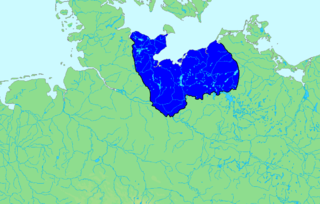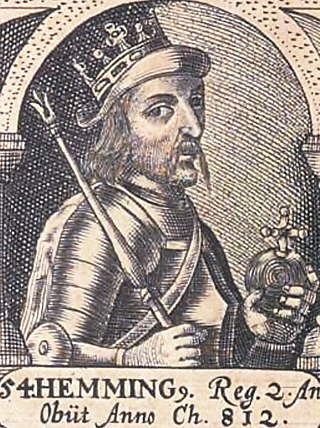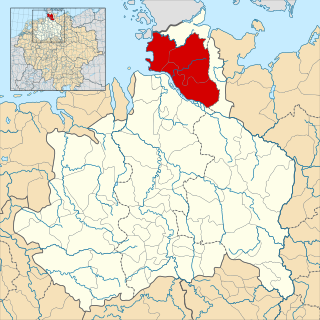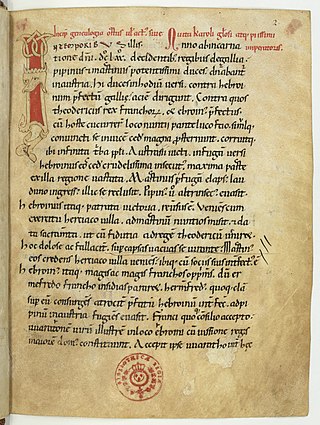
Wends is a historical name for Slavs who inhabited present-day northeast Germany. It refers not to a homogeneous people, but to various people, tribes or groups depending on where and when it was used. In the modern day, communities identifying as Wendish exist in Slovenia, Austria, Lusatia, the United States, and Australia.

The Obotrites or Obodrites, also spelled Abodrites, were a confederation of medieval West Slavic tribes within the territory of modern Mecklenburg and Holstein in northern Germany. For decades, they were allies of Charlemagne in his wars against the Germanic Saxons and the Slavic Veleti. The Obotrites under Prince Thrasco defeated the Saxons in the Battle of Bornhöved (798). The still-Pagan Saxons were dispersed by the emperor, and the part of their former land in Holstein north of Elbe was awarded to the Obotrites in 804, as a reward for their victory. This however was soon reverted through an invasion of the Danes. The Obotrite regnal style was abolished in 1167, when Pribislav was restored to power by Duke Henry the Lion, as Prince of Mecklenburg, thereby founding the Germanized House of Mecklenburg.

Hemming I was a king in Denmark from 810 until his death. He was the successor of King Gudfred, his uncle.

Gudfred was a ninth century Danish king who reigned from at least 804 to 810. Alternate spellings include Godfred (Danish), Göttrick (German), Gøtrik (Danish), Gudrød (Danish), and Godofredus (Latin). He stands at the threshold of the History of Denmark in the sense that he is the first ruler about whom there is substantial knowledge from contemporary sources. He waged offensive war against the Carolingian Empire with some success, but was murdered under murky circumstances before a major confrontation had taken place. There is no unambiguous trace of Gudfred in the later Norse sagas, and his history can only be traced from the hostile Frankish texts which makes an assessment of his role problematic. His paternity is unknown but he may have been closely related to Sigfred, who preceded him as king of Denmark c. 770–804. He was the uncle of the later Danish King Hemming (810–812) and the father of King Horik I (813–854).

Polabian Slavs, also known as Elbe Slavs and more broadly as Wends, is a collective term applied to a number of Lechitic tribes who lived scattered along the Elbe river in what is today eastern Germany. The approximate territory stretched from the Baltic Sea in the north, the Saale and the Limes Saxoniae in the west, the Ore Mountains and the Western Sudetes in the south, and Poland in the east.

The Chronicle of Moissac is an anonymous compilation that was discovered in the abbey of Moissac, but is now thought to have been compiled in the Catalan monastery of Ripoll in the end of the tenth century. Like most chronicles, it begins with Adam, but gains increasing interest for historians as it nears its end date of 828. Unfortunately, a folio with the entries covering the years 716–770 is missing. The only surviving manuscript of the Chronicle of Moissac dates from the later 11th century and is now in the French National Library in Paris.

The Royal Frankish Annals, also called the Annales Laurissenses maiores, are a series of annals composed in Latin in the Carolingian Francia, recording year-by-year the state of the monarchy from 741 to 829. Their authorship is unknown, though Wilhelm von Giesebrecht suggested that Arno of Salzburg was the author of an early section surviving in the copy at Lorsch Abbey. The Annals are believed to have been composed in successive sections by different authors, and then compiled.
Harald 'Klak' Halfdansson was a king in Jutland around 812–814 and again from 819–827.
Thrasco (*Daržĭkŭ) was the Prince (knyaz) of the Obotrite confederation from 795 until his death in 810. He succeeded his father, Witzlaus II, who had been ambushed and killed by the revolting Saxons. Thrasco defeated the Saxons in the battle on Schwentine River in 798. He was murdered in Reric in 810. Thrasco had a son, Cedragus, the Obotrite prince from 819 to 826.

Nordalbingia was one of the four administrative regions of the medieval Duchy of Saxony, the others being Angria, Eastphalia, and Westphalia. The region's name is based on the Latin name Alba for the Elbe River and refers to an area predominantly located north of the Lower Elbe, roughly corresponding with the present-day Holstein region. Situated in what is now Northern Germany, this is the earliest known dominion of the Saxons.
Henry was an Obotrite prince or king (1093–1127) from the Nakonid dynasty; he was regarded by contemporaries as "King of the Slavs". The Obotrite realm reached its greatest area during Henry's rule, extending from the Elbe to the Oder and from the Havelland to the Baltic Sea.

The Glomacze or Daleminzi, were a West Slavic tribe of Polabian Slavs inhabiting areas in the middle Elbe (Łaba) valley. According to early 11th century chronicler Thietmar of Merseburg, they were called as Daleminzi by the Germans, and as Glomacze by the Slavs.

The Guduscani or Goduscani were a tribe whose location and origin on the territory of early medieval Croatia remains a matter of dispute. According to different hypotheses, they were a tribe or clan of Croat, Slavic, Avaric or Gothic origin that was located around present-day Gacka (Lika), between upper Kupa River and the Dalmatian coast, or that were inhabitants around the river Guduča near the Bribir region.

The Melingoi or Milingoi were a Slavic tribe that settled in the Peloponnese in southern Greece during the Middle Ages. In the early decades of the 7th century, Slavic tribes (Sclaveni) settled throughout the Balkans following the collapse of the Byzantine Empire's defense of the Danube frontier with some groups reaching as far south as the Peloponnese. The Sclaveni often settled in small groups and their demographic impact in mainland Greece was both weak and diffuse. Of these, two groups are known by name from later sources, the Melingoi and the Ezeritai, of whom the Melingoi settled on the western slopes of Mount Taygetos. The origin and etymology of the name Melingoi is unknown.

The Sorbs, also known as Serbs or White Serbs in Serbian historiography, were an Early Slavic tribe settled between the Saale-Elbe valley and the Lusatian Neisse. They were part of the Polabian Slavs and Wends group of Early Slavs. In the 7th century CE, the tribe joined Samo's Empire, and some Sorbs emigrated from their homeland to Southeast Europe. The tribe is last mentioned in the late-10th century, but its descendants can be found among Germanized people of Saxony, among the Slavic ethnic group of the Sorbs in Lusatia, and among the Serbs of Southeastern Europe.
Praedenecenti was an early medieval Slavic tribe, mentioned only in the Royal Frankish Annals in 822 and 824. They lived in the buffer zone between the Carolingian and Bulgarian empires. The Royal Frankish Annals associated them with the Abodriti, while modern scholars have also connected them to other Slavic tribes, especially the Braničevci or Merehani. The Praedenecenti sought assistance from the Franks against the Bulgars, but they obviously lost their independence because they were not mentioned after 824.

The terms Danish March and March of Schleswig are used to refer to a territory in modern-day Schleswig-Holstein north of the Eider and south of the Danevirke. It was established in the Early Middle Ages as a March of the Frankish Empire to defend against the Danes. The term "Danish March" is a modern designation not found in mediaeval sources. According to the Royal Frankish Annals, the Danish King led his troops "into the March" in 828. In the 852 Yearbook of Fulda, there is mention of a "Guardian of the Danish Border".
The Linones were a small Slavic people first recorded in the early 9th century. They lived north and east of the Elbe, across from Höhbeck in the region around Lenzen, south of the Wilzi and Obotrites, north of the Hevelli and northeast of the Saxons. They may have been a sub-group of the Wilzi and were often under Obotrite control. They may be associated with the medieval Gau Liezizi.
The Bethenici were a West Slavic people living east of the Elbe river in the ninth century. They lived near the confluence of the Elbe and the Havel, probably between the rivers alongside the Smeldingi.

The Chronicle of Aniane is an anonymous Latin history covering the rise of the Carolingian family from 670 to 840. It was composed by a monk of the Abbey of Aniane (Hérault).